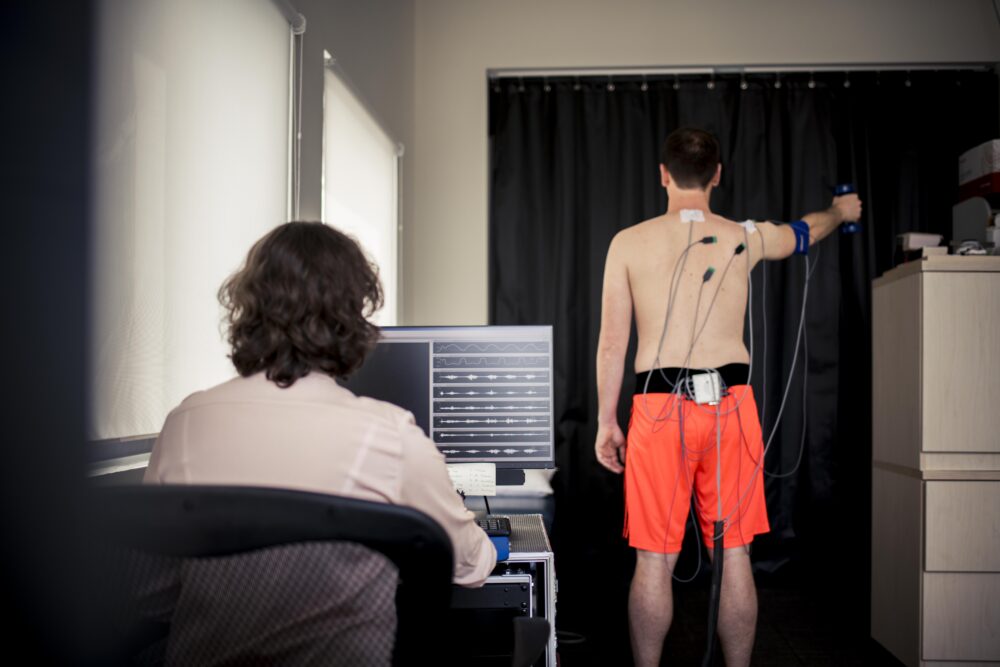Foundation Researcher Spotlight: Lori Michener Revolutionizing Treatment for Musculoskeletal Shoulder Pain
Foundation Researcher Spotlight: Lori Michener Revolutionizing Treatment for Musculoskeletal Shoulder Pain
Lori Michener, PhD, PT, FAPTA is a professor at the University of Southern California. She is the recipient of the 2022 Paris Patla Physical Therapy Research Grant.
Can you tell me a little bit about yourself and your personal background?
I was raised in a small town outside of Philadelphia called Columbia. My journey to college was unique as I was a first-generation student. My ambition was to be a physical therapist, which led me to undertake a pre-undergraduate Health Science major at Lock Haven University. Here I took the pre-requisites for physical therapy and also classes and training to become an athletic trainer. Subsequently, I enrolled in physical therapy school at SUNY at Buffalo. My career path took me back to Lock Haven University teaching in the Health Science Department and working in collegiate athletics, as well as treating patients in a local hospital and outpatient clinic.
I found myself driven to understand how we could better treat and prevent injuries, especially those grappling with musculoskeletal pain from high-end athletes to older individuals having difficulty with daily activities. During my first 6 years of clinical practice I continued to ask more questions that did not have answers in the current literature. That is when I decided to return for a Ph.D., and was lucky to be accepted into the Orthopedics / Biomechanics program at Hahnemann University in Philadelphia, which is now known as Drexel University. Next up, I moved into an academic position at Virginia Commonwealth University, where I taught in their physical therapy program and developed a research lab to investigate mechanisms and treatment for patients with musculoskeletal shoulder pain. After a fulfilling 15-year tenure, my husband’s desire to relocate to the West Coast led us to Los Angeles. I was incredibly fortunate to be hired as a professor in the Division of Biokinesiology and Physical Therapy at the University of Southern California, where I serve as the Director of Clinical Outcomes and Research, and direct the COOR research lab.
What made you want to become a PT?
My participation in various high school sports, despite not experiencing common athletic injuries, coupled with my extroverted nature and passion for helping people, led me to explore a combination of athletic training and physical therapy. Interestingly, I stumbled into athletic training without prior knowledge of it. My undergraduate years were primarily focused on obtaining the prerequisites for physical therapy school, driven by my volunteer experiences in the hospital. It was during my time at Lock Haven University that I discovered the intricacies of athletic training and decided to merge it with my interests in sports and orthopedics.

What teaching experiences have impacted your professional journey?
My early experience teaching at Lock Haven University in an undergraduate-oriented setting left a lasting impact on my teaching skills. The diverse department, comprising various health science disciplines, including health education, physiology, and anatomy, played a crucial role in broadening and enriching my teaching skills. I gleaned valuable teaching insights from the strong educators across the department – for which I am very grateful. My department chair and the athletic training program director were pivotal mentors on my academic journey. Their encouragement and recognition of my curiosity, especially in seeking better treatments for patients, eventually motivated me to pursue a Ph.D.
These experiences significantly influenced my 15-year teaching and research tenure at VCU. There, I faced the challenge of balancing teaching, research, and practice while also integrating service into my academic position. Since joining USC, the research approaches and methods I use have significantly expanded, to include integrating the influence of the brain on rotator cuff tendinopathy. This journey has been both rewarding and enlightening, broadening my perspectives, and opening new avenues of exploration.
What research have you been working on?
My research has predominantly revolved around musculoskeletal shoulder pain, with a particular focus on rotator cuff tendinopathy, also known as subacromial shoulder pain. My research portfolio encompasses mechanistic investigations to understand the underlying causes of shoulder pain, along with identifying how and why treatment approaches can improve pain and disability. I also engage in clinical trials to assess the effectiveness of rehabilitation treatments to improve patient outcomes, with a focus on musculoskeletal shoulder pain. What has recently intrigued me are those patients with rotator cuff tendinopathy who exhibit delayed or non-recovery after treatment. This specific group, which makes up around 40% of cases, piqued my curiosity. I wanted to understand what factors contribute to their prolonged recovery or lack of response to treatment. The goal is to identify these factors and associated biomarkers to target for patient-specific matched treatment approaches.
This quest led me to apply for a Foundation Grant, which, fortunately, I was awarded. The grant is directed towards understanding how the rotator cuff tendon morphology changes with resistance exercise delivered in physical in individuals with tendinopathy. This knowledge will inform the design of a patient-specific resistance exercise approach based on tendon recovery, and identify factors associated with non-response so they can be stepped to alternative care to optimize patient outcomes
What role has the Foundation played in your research so far?
As a doctoral student, receiving a $6,000 grant for my research was an immense support. It facilitated my dissertation, a critical step in establishing the foundation for my subsequent career. The research focused on unraveling the mechanisms and clinical effectiveness of managing shoulder rotator cuff tendinopathy. Subsequently, the next foundation grant I received has proven to be indispensable in acquiring pilot data to support my application for an NIH grant.
What is the value of physical therapy research? Who does it benefit, and how?
From my perspective, physical therapy research holds immense value in the realm of non-operative approaches to treating patients with shoulder pain. By identifying the mechanisms underlying pain and recovery, we can better tailor our treatments with the goal of improving patient outcomes. More recently, intriguing questions I’ve been exploring is the role of early patient education, cognitive-behavioral therapy to address psychological factors, and the delivery of interventions via telehealth. Telehealth can be particularly beneficial for individuals who have limited access to healthcare services or face constraints on their time, such as those with limited vacation and sick time. By offering alternative ways of delivering care, we can extend our reach and help a broader range of patients. This aligns with my commitment to making physical therapy more accessible to those who need it most.
Any final thoughts or comments?
I’d like to extend my heartfelt gratitude to the Foundation for Physical Therapy for their unwavering support of my research. Their funding has been instrumental in shaping my journey and contributing to the progress of physical therapy research.
this work and continue to be involved moving forward.

STAY CONNECTED
Use this form to sign up for the Foundation for Physical Therapy Research monthly newsletter.